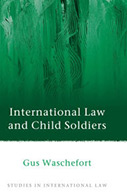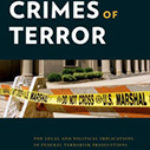International Law and Child Soldiers

Author: Gus Waschefort
Publisher: Oxford, UK; Portland, OR: Hart Publishing, 2015. 264p.
Reviewer: Maria Pichou | September 2015
This new book from Gus Waschefort, associate professor of international law at the University of South Africa, analyses the international legal framework for prohibiting child soldiering, and does so effectively. At the outset, Waschefort explains his intention: “this study is aimed at achieving an era of application by materialising the relevant law” on child soldiering (p. 19). In order to achieve this “era of application”, the author asserts that the focus of international law should be shifted from norm creation to norm enforcement.
The stated purpose of this work is to advance three major arguments: Firstly, that there are norms set in place for the prevention of child soldiering, and what is lacking is their application. Secondly, that the refinement of the existing enforcement mechanisms will empower the preventive role of international law. Thirdly, the author considers that the conclusions of his work constitute the necessary step in preventing child soldiering: “the findings in this study are the next step in child soldier prevention, and a necessary component in eventually achieving broad-based social change” (p.219). Waschefort concludes by stating that only when “an era of application” of international law on child soldiering ends and is no longer needed, then the true social change will have been achieved. In other words, when the application of international law rules on child soldiering is no longer necessary, the social phenomenon of child soldiers may be eclipsed. As hopeful as this conclusion may be, the reasoning seems a bit circular.
The book is ordered thematically. After setting the background and explaining his standpoint in the first chapter, the author proceeds with a social analysis on the causes of child soldiering in the second chapter. In chapters three, four and five, there is a systematic and rigorous analysis of the normative framework of international humanitarian law, international human rights law and international criminal law on child soldiers. The author assesses the different institutions and mechanisms that engage with child soldiering in chapter six. In chapter seven, Waschefort employs a case study of the Democratic Republic of the Congo (DRC), in order to investigate whether international law has a role to play in preventing the use and recruitment of child soldiers. Finally, his concluding remarks appear in chapter eight.
The author begins with a strong analysis regarding the definition of child soldier. He also explains his choice of terms successfully. He prefers using the term “child soldier” to the term “child associated with an armed force or armed group”, used instead by NGOs. A good example of Waschefort’s comprehensive, rigorous and systematic analysis appears in chapter three, where he discusses the relevant provisions of international humanitarian law on child soldiering. The shortcomings of the Geneva Convention IV, namely its application only during occupation and armed conflict, are also identified. Waschefort asserts that the Additional Protocols to the Geneva Conventions are in every way more suited to the prevention of child soldiering and he moves on with identifying the distinctions between the two protocols. The author highlights the lowest common denominator between the two protocols and he explains why protocol I offers little protection to children and why conversely protocol II contains the most absolute prohibition of child soldiering to date.
According to Waschefort, child soldiering is a social phenomenon that can be addressed and prevented through (what he calls) the “instrumentality” of international law (p. 25). He appears to be referring to law as a device used to engineer social changes. After reviewing criticisms of this theory, Waschefort adopts an instrumentalist view of international law specifically in the field of preventing child soldiers. He believes that international law plays a dual role in addressing the issue of child soldiering, claiming that international law primarily plays a reactive role to redressing child soldiering and it has a less perceptible role in preventing violations. Indeed, international law has always been inherently reactive to problems. Waschefort then turns to explaining why international law’s reactive role is important in combatting child soldiering while its preventive role will become effective once the scope of the phenomenon is diminished.
Although the author affirms that the extent of the problem of child soldiering cannot be assessed quantitatively due to lack of consistent information, he acknowledges that it is of global proportions. He accurately points out the rarely acknowledged issue of the strategic use of child soldiers as an asymmetrical conflict structure and he observes poignantly that “international law does not prohibit a child from being a soldier; it prohibits the use and recruitment of children” (p.52).
Waschefort’s observation that international law is not aimed at the supply of child soldiers but at their demand is interesting. As he has made clear, international law needs to deal with the demand for child soldiers if it wants to be effective in preventing child soldiering. The author vouches for a broad-based approach aimed at the prevention of armed conflicts, instead of a direct approach aimed at preventing only the phenomenon of child soldiering, independent of the prevention of armed conflicts. In this regard, Waschefort’s interview with the Special Representative to the Secretary-General on Children and Armed Conflict (SRSG) is fruitful. Although the SRSG adopted the direct approach to child soldiering, the author states that a broad-based approach may bring more positive results in preventing child soldiers.
Waschefort argues that the current normative framework on child soldiering is sufficient, but what is lacking are changes in the refinement and reassessment of the existing rules. It is not clear, however, what exactly he means by “refinement” and “reassessment” of the existing rules. Furthermore, such an argument may end up being controversial, given that one could argue that the existing framework may not be considered ultimately sufficient if the existing rules need refinement and reassessment. The argument is made that the international community should refrain from creating more norms until the current norms are fully enforced. Idealistic as such an approach may be, the fact is that new norms may be created in order to promote the enforcement of existing mechanisms. The author is honest, however, in his intention not to simply discuss the imperfection of the existing norms but to find a way to enforce these rules, as imperfect as they may be: “We should not simply accept the weaknesses of the positive law. Instead, we should now put greater emphasis on enforcing these imperfect, but necessary standards.” (p.9)
The author also advocates for an “issues-based” approach to child soldiering in an attempt to avoid discussion about the hierarchy between the different branches of international law applicable to child soldiering. Nonetheless, the chapters of his book are divided thematically and each “regime” of international law on child soldiering is analysed in different chapters. Having said this, the author recognises that this method may be sterile and he calls the reader to view each chapter holistically and not in isolation. Moreover, in chapter four, Waschefort provides a useful overview of international humanitarian law and international human rights law as an integrated international law response to the prevention of child soldiering. The author argues for a holistic approach to the different regimes of law on child soldiering. This entails a comprehension of these regimes and of their implementation, and that is what the author is attempting to provide in chapters three, four and five.
Additionally, the special focus on the applicability of the different legal regimes vis-à-vis the non-state actors is timely and instructive. The analysis on the principles that should be employed for solving norm conflicts between international humanitarian law and international human rights law is also clearly outlined. As customary law transcends the distinction between the two different branches of international law, the author argues clearly that customary law contains a broader prescriptive content than the treaty norms do on the issue of the use and recruitment of child soldiers.
Waschefort raises also the issue of lack of consistency between the approaches of the international tribunals on the war crime of child soldier use and recruitment. The author reiterates the view that under international criminal law (as well as under international humanitarian law) the “direct” and “active participation” of children in hostilities amount to the same standard. Despite the Report of the Preparatory Committee on the Establishment of an International Criminal Court and the ICC’s interpretation of the distinction of the two notions, the author explains successfully why determining a form of a child’s participation as active needs to be made on a case-by-case basis.
Towards the end of his work, the author reviews the international courts and institutions engaged with the phenomenon of child soldiering. The focus is on institutions, which have the possibility of directly enforcing rules that prohibit child soldiering. For this reason, the author provides an overview of the relevant institutions of the United Nations and of the African Union, according to their relative powers to engage directly with it. The author’s aim is to demonstrate those areas of engagement best suited to child soldier prevention and to assess them critically. The mere enumeration of all the organs dealing with child soldiering may be at times tiring for some readers; however, the critical review of their role is very welcome. Waschefort’s suggestions on the changes that need to take place in order to enforce the existing structures are equally so. Indeed, the author offers a few proposals so that these institutions and functionaries increase their level of engagement with child soldier prevention. Noteworthy among them is the author’s urge for the Security Council to take stronger action. According to Waschefort, monitoring and reporting must be coupled with targeted sanctions on persistent violators in order to have a greater effect on child soldier prevention.
Waschefort reaches his concluding chapter with a case study of the DRC, in which he explains in detail the reasons why he selected this case. He also justifies effectively the choice of his methodology. The interviews were conducted with UN and NGOs functionaries rather than with any actual child soldiers. Although it is a case study, the author returns to the basic premise of his book — whether international law and, more specifically in this chapter, international criminal prosecutions — played any role in preventing child soldiering in the DRC. Through his case study, Waschefort emphasizes that the International Criminal Court (ICC) may have a deterrent effect in a given country, as long as the fear of prosecution is real for persons against whom ICC arrest warrants have been issued. Overall, the author adopts a holistic approach to the issue of child soldiers in international law and he succeeds in his aim. The book provides the reader with a good understanding of child soldiering as a social phenomenon and of the role that international law can play in its prevention.
Dr. Maria Pichou,
Postdoctoral Researcher/Senior Researcher in Public International Law, University of Luxembourg, Faculty of Law


